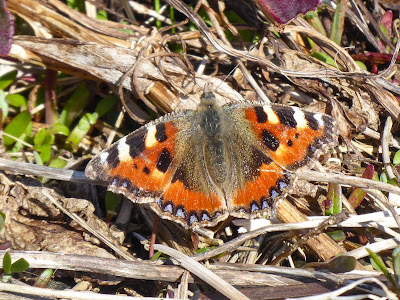A WSW light wind to start with, moving to WNW by evening. Sunny all day.
Pete managed a short seawatch 08:10- 09:10
Red-Throated diver 7
Common Scoter 1
Red-breasted Merganser 5 out
Little Egret 1 flew across bay towards Ulverston
Later
Gannet 1, plus another Red-Throated diver
South shore
Wheatear 4
Rock pipit 4 probably 5
 |
| These pictures from Kevin. This is the ringed male Rock Pipit |
 |
| Rock Pipit and Wheatear sharing a perch |
Swallow 1 north
 |
| The butterflies are starting to fly again - Small Tortoiseshell |
Middleton Nature Reserve late morning
Mute swan 3 adult plus 3 immature on the main pond. 2 adult each Tim Butler and "No swimming" ponds.
Canada goose 2 main pond
Mallard 3
Little grebe 1 trilling on main pond
Swallow 1 north
Cetti's warbler 1 - just the "no swimming" male heard
Several Chiffchaff and Willow Warblers heard/seen, but no other warblers.
Heysham skeer - low water 17:50
The wind was a bit stronger by this time, a wind surfer was taking advantage of the conditions, unfortunately clearing the sea of birds.
These Eider took flight, the purple shape is the wind surfer's "kite".
 |
| Today, it was a Herring gulls turn to strike a pose |
Right, back to the honeycomb worms, I'm sorry for going on about this, but it represents a significant change in local bird behaviour, with ramifications for the topography of the skeer. (MD)
This morning, at least 150 Turnstone returned to the wooden jetty to roost after feeding on the skeer. They must have been well sated, as this evening no more than 20 returned to the skeer.
The tide went out further today revealing the honeycomb beds the Turnstone were feeding on yesterday.
 |
| You can see how segments have become separated, making it easier for the Turnstone to prise away the edges to reveal the worms. |
Oystercatchers have longer stronger bills and could feed on the worms anywhere, when the tide is rising around the beds. Unfortunately Oystercatchers are normally very loyal to their preferred feeding method. But not today! There were c700 Oystercatcher feeding on the honeycomb worms. This is new, I've never seen anything eat the worms till this set of tides. Yesterday there was a smallish group of Oystercatchers on the southern edge feeding near the Turnstone, today they were on the quite pristine beds in the centre of the skeer.
This first short clip is just to show that it is the worms that they are eating. Watch the bird just right of centre, at the front.
This clip is a section of the feeding birds.
Quite a number of these are immature birds, so hopefully developing feeding methods for life. It looks like they are devastating the Honeycomb worms, but this next picture puts it into prospective:
 |
| The c700 Oystercatchers are the pale smear in the mid ground. This picture still only shows 30% of the extent of the beds on the middle skeer |
Hopefully the change in feeding will be maintained, perhaps it is only practical in the worm's breeding season, I have no idea at the moment. But even if the Oystercatchers do continue feeding this way, they will make little difference in the short term, but it will surely tip the balance back to mussels in the longer term.